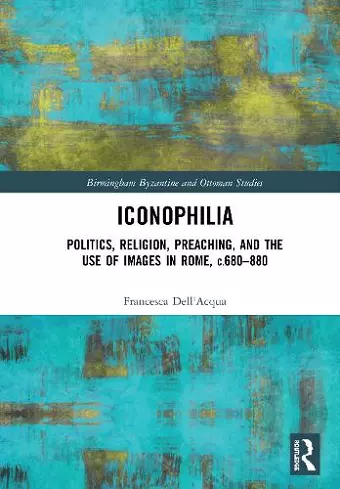Iconophilia
Politics, Religion, Preaching, and the Use of Images in Rome, c.680 - 880
Format:Hardback
Publisher:Taylor & Francis Ltd
Published:26th May '20
Currently unavailable, and unfortunately no date known when it will be back
This hardback is available in another edition too:
- Paperback£42.99(9781032235936)

Awarded the Accademia Nazionale dei Lincei’s Mario Di Nola Prize 2023
Between the late seventh and the mid-ninth centuries, a debate about sacred images – conventionally addressed as ‘Byzantine iconoclasm’ – engaged monks, emperors, and popes in the Mediterranean area and on the European continent. The importance of this debate cannot be overstated; it challenged the relation between image, text, and belief. A series of popes staunchly in favour of sacred images acted consistently during this period in displaying a remarkable iconophilia or ‘love for images’. Their multifaceted reaction involved not only council resolutions and diplomatic exchanges, but also public religious festivals, liturgy, preaching, and visual arts – the mass-media of the time. Embracing these tools, the popes especially promoted themes related to the Incarnation of God – which justified the production and veneration of sacred images – and extolled the role and the figure of the Virgin Mary.
Despite their profound influence over Byzantine and western cultures of later centuries, the political, theological, and artistic interactions between the East and the West during this period have not yet been investigated in studies combining textual and material evidence. By drawing evidence from texts and material culture – some of which have yet to be discussed against the background of the iconoclastic controversy – and by considering the role of oral exchange, Iconophilia assesses the impact of the debate on sacred images and of coeval theological controversies in Rome and central Italy.
By looking at intersecting textual, liturgical, and pictorial images which had at their core the Incarnate God and his human mother Mary, the book demonstrates that between c.680–880, by unremittingly maintaining the importance of the visual for nurturing beliefs and mediating personal and communal salvation, the popes ensured that the status of sacred images would remain unchallenged, at least until the Protestant Reformation in the sixteenth century.
‘This is an enormously wide-ranging study. The author has deep knowledge of the theological debates, their various protagonists, and the surviving written texts, and this extends impressively to both Latin and Greek authors. In juxtaposing the two categories of document – writing and monument – Dell’Acqua offers an insightful view into early medieval Italian thinking about the orthodoxy of images and their role in contemporary religious practice’ - Early Medieval Europe, 30 (2), 2022.
‘This is an ambitious book on an important topic, in which the principal arguments are laid out with laudable clarity – no mean feat given the ever-expanding thicket of scholarship on Byzantine iconoclasm and reactions to the controversy in the medieval West … Dell’Acqua’s research makes a major contribution to the study of the rise of the cult of the Virgin in the medieval West, underscoring the role of images in its formulation and promulgation … All in all, Dell’Acqua’s study serves as a reminder and reinforcement of the extent to which the period in question established the foundations for habits of figuration that collectively served as the cornerstone of western religious art – and hence of western art as a whole – for much of the following millennium’ - The Burlington Magazine, January 2022.
ISBN: 9780415793728
Dimensions: unknown
Weight: 980g
416 pages